The Sinclairs, the Templars, and DNA
Nobody likes a party pooper.
Even with so much written about our family’s connections to the Order of the Temple, I had always been doubtful. After all, no one could find a single piece of definitive physical evidence - written or in stone - to absolutely, inarguably prove it. Since we started this DNA study in 2004, many people assumed we could use DNA to solve the question of a Templar connection. “After all,” they would argue, “there is so much other proof.”
“Steve, what about the 2 men on the horse in Rosslyn Chapel?” - The truth is, it’s one man on a horse and another behind the left flank of the horse.
“But Steve, Hugh de Payens, founder of the Templars, was married to Catherine St. Clair.” - No, actually he was not married to a St. Clair. This is a recent invention.
“But Steve, Dan Brown named your family in his famous book.” - Right. You’ll find it in the fiction section of your local library.
This lack of evidence is enough to lead many skeptics towards total cynicism. Not me. I kept an open mind, and this paid off.
Feet on the ground - France
In February 2014, after extensive research into the benefaction of medieval French abbeys and priories, I flew to France to see some particular sites for myself. As usual, there was no substitute for being on the ground, studying the proximity of historic buildings, and finding other information not available in books or online.
Once again I skipped the well-trod ground of our Saint-Clair history to look into unusual locations. In 2011, this approach helped me solve the identity of our Herdmanston lineage, and I felt sure it would help me understand our history in France. Most St Clairs would have wanted to go to Normandy, but I had more interesting places in mind. More on that shortly.
Scott Wolter and H2 joined me
Some of you visiting this page are here because you saw my friend Scott Wolter and I on the History Channel’s (H2) show, America Unearthed. When Scott learned I was in France, he flew over to meet me. Committee Films, the production company who films America Unearthed, came along to film our exploration of several locations in France, including two that were incredibly important to me. We also brought our wives with us. They aren't in the episodes, which is too bad because it would have been a better-looking show :)
The perfect place to meet up was at Troyes, where the story of the Knights Templar began.
Not accounting for commercials, TV shows like this one are limited to about 44 minutes of material. So there’s no way they could go into the specifics of all my research on the places I’ve been exploring before, during, and after the trip to France. This web page covers my recent research in great detail.
Understanding SuperFamilies
After 10 years of research into our medieval history, I’ve come to understand the fluid nature of surname usage in medieval Normandy and England. Here is just one of many examples:
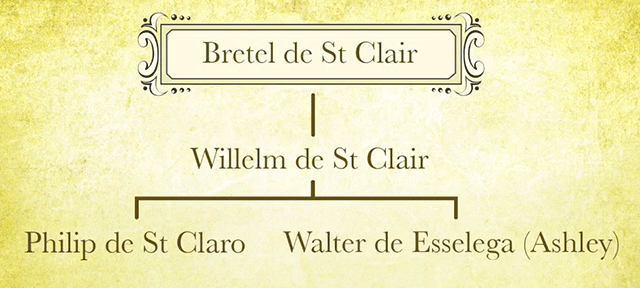
(KR-1, p. 686), Esselega held Stoke Trister in 1166.
Willelm’s son Walter used a different second name (Ashley / Ashbrittle), no doubt because he took the name of his land called Ashbrittle (Esselega is the latinized form). In Domesday book (1086), Ashbrittle was held by Bretel St. Clair. His tenant-in-chief was Robert de Mortain, half-brother of William the Conqueror. By 1210-12, Esselega held ten knight’s fees of Mortain, including Ashbrittle, Stoke Trister, and Cucklington. All of those were formerly held by Bretel St. Clair.(KR-1, p. 449)
A discovery in France
Much of my research into SuperFamilies has come from books like Calendar of Documents Preserved in France: Illustrative of the History of Great Britain and Ireland. This book was edited by one of the most respected medieval historians in the world, J. Horrace Round, M.A. (1854–1928).
In this treasured resource, I prepared for my trip to France by looking for any surname connections to French priories and abbeys with particular families who fit into the known narrative of our family lineages. If you know the real story of a medieval family - the actual document history showing other surnames circling around our own - then you can look for similar matches in our DNA SNPs. Not just DNA markers, but Single-Nucleotide Polymorphisms, matches with other surnames which are irrefutable.
One priory in particular blew what is left of my hair back: Saint Martin des Champs in Paris.
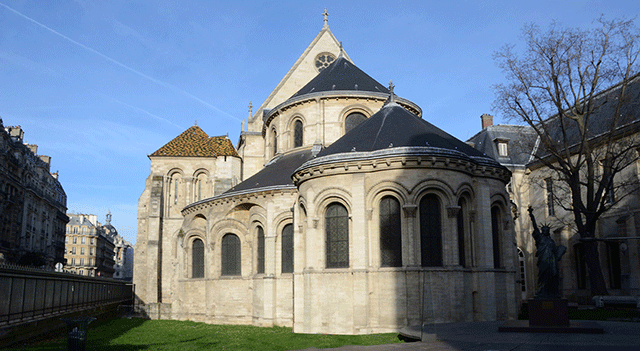
St Martin des Champs from the southeast. Photo by Steve St. Clair 2014.
About St. Martin des Champs
The oldest known structure at this site was a chapel dedicated to St. Martin of Tours. It was founded during the Merovingian dynasty and built over a Merovingian necropolis, a practice I’ve seen at other religious houses. The location is now inside the city limits of Paris. When it was built, it was outside the walls of Paris, thus the name des Champs: “in the fields.”
Years later, a community of monks established themselves around this Merovingian site and founded a small abbey. In the late 900s, Norman invaders destroyed that one. Later, King Henry I (1008 - 1060) rebuilt St. Martin.
St. Martis des Champs became a cluniac priory in 1079. It would become one of the most important houses of the order of Cluny, in part because of the powerful benefactors who took such an interest in it:
- Stephen of Aumale, son of Odo count of Champagne
- Robert de Vaux
- Robert Arundel
- William de Brus
- Baldwin de Redvers
- Stephen de Mandeville
What I found out about the intersections of these families - this SuperFamily - surprised me. At last, actual evidence of Templar connections to a SuperFamily which includes one of our 12 Saint-Clair lineages; our Herdmanston lineage.
SuperFamily: a grouping of people with different surnames who were benefactors to the same medieval abbeys and priories, hoping the monks would prey for their souls and those of their ancestors. They also showed up in land records, and marriages among the same families again and again. Many of these people shared male ancestry, YDNA, even though they had different surnames.
So when we see these same surnames matching in YDNA SNPs, we can rightly assume these people, living today, are the male descendants of the medieval people who were together in the records.
An example: There are medieval records showing strong interactions between Geoffrey de Mandeville and Hamo de St Clair. ALSO there is currently only one of our DNA lineages which shows an SNP connection to people alive today with the surname Mandeville – our Saint-Clair Herdmanston lineage.
Another way to describe the process above: a criterion of multiple independent connections. Our Herdmanston lineage’s connections to the Mandevilles and other families in medieval records plus in modern DNA SNP matches is just that: it shows multiple independent connections.
Full disclosure: I, Steve St. Clair, am NOT a direct male descendant of the Herdmanston Lineage of the Saint Clair family. They show the P310 SNP and I have L193, meaning we don’t share a male ancestor for about 4,000 years. However, I have strong evidence that I descend from a female member of the Herdmanston St. Clairs in the early 13th century.
About the Cluniac Order
Because St. Martin des Champs was a Cluniac house, I began to study the Cluniacs. When Cluny was founded, about 910 AD, the order followed the utmost self-denial of the strict Benedictine Rule. (Webster, p. 145) Their early reputation for severity would later inspire the Cistercian order, founded in 1098.
In one of the volumes of Proceedings of the Battle Conference, author Brian Golding wrote an article The Coming of the Cluniacs which made it clear that, while the benefactors of abbeys and priories were eclectic in their benefaction, the English earls gave more generously to their Cluniac houses.
Golding (p. 75) went further to point out that William, count of Mortain, who founded Montacute (also a Cluniac priory) was strangely interested in Montacute to the exclusion of his other foundations. He founded Montacute in 1100 and the “most interesting and strange aspect is the fact that he not only granted away a considerable proportion of his Somerset demense [land attached to a manor and retained for the owner's own use], but also alienated the caput of his Somerset estates together with his castle. It is almost as if he was dismantling his interests in the county, and is a feature that needs further elucidation.”
Note the founding of Montacute in the same year that Stephen of Aumale became a benefactor of St. Martin des Champs.
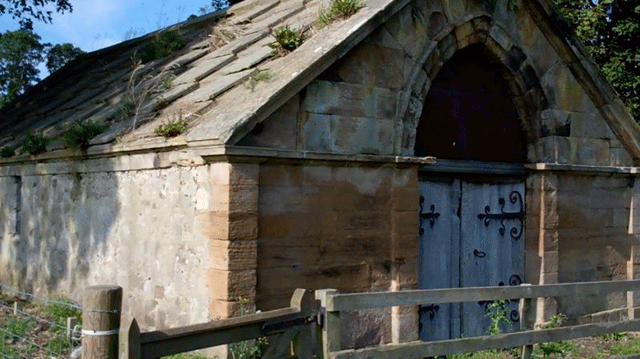
The small chapel at Herdmanston, burial vault for the St. Clairs since the 1200s. Photo, Steve St. Clair 2012
A quick recap of our Herdmanston lineage
Herdmanston is about 15 miles east of Edinburgh. It adjoins a piece of land called Saltoun, owned by the Moreville family in the middle ages. The Morevilles were Lords High Constable of Scotland, ranking above all other titles with the exception of the royal family. The same year Hugh de Moreville died and his son Richard became Constable, the St. Clairs were granted Herdmanston.
The descent of the wife of Hugh's son Richard is quite interesting. I'll explain the Warenne connection shortly.
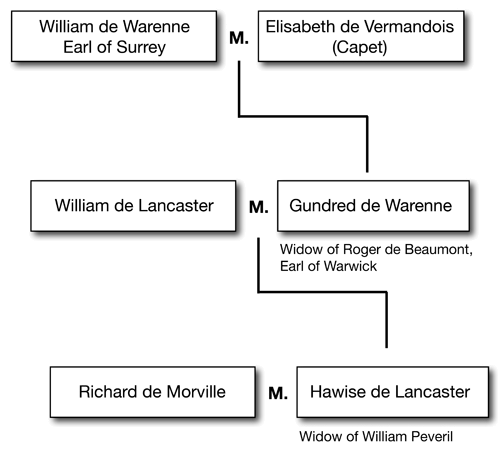
The St. Clairs have held Herdmanston since 1162 when they received it from Richard de Moreville. They own it to this day. The Morevilles were closely allied with, and possibly of the same paternal bloodline of the Redvers family. The Redvers were widely involved in benefaction to many religious orders – (hedging their bets?). In about 1143, Baldwin de Redvers founded the small priory of St. James Exeter for Cluniac monks. It was founded as a daughter house of St. Martin des Champs (Britnell p. 5).
Baldwin de Redvers went on crusade with Stephen de Mandeville. But wait, it gets more interesting: Green (p. 197) says Geoffrey de Mandeville "came from Magneville in the Cotentin, threee miles from Nehou, the chief manor of Richard de Redvers honour." This Nehou family were regular witnesses to the charters of the Moreville family, the very same who gave the land of Herdmanston to our Herdmanston St. Clairs. The connections are too strong to ignore. If you really want to dig into the inter-relationships between Eudo Dapifer, Redvers, the St. Clairs, and the Mandevilles, see Vincent, p. 243.
To read the more details on the Saint-Clairs of Herdmanston, and the Redvers, Morevilles, etc. click here.
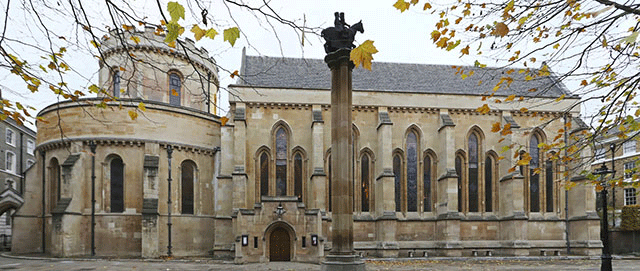
Temple Church, London. Photo from ThinkStock
And, now, the first of several Templar connection
In a chapter called "Medieval Burials and Monuments," Griffith-Jones (p.73) makes the case that Geoffrey de Mandeville was the founder of the Temple Church in London. This was the most important Templar church in England. Cistercian founders were often buried in the "porch" part of the church, "like the dukes of Burgundy at Citeaux itself" (Griffith-Jones p.74). Geoffrey's burial in the "cemetery or porch at the New Temple would have been entirely consistent with this quasi-Cistercian tradition."
Christopher Wilson argued that the porch in the Temple Church in London imitated a "similar feature of the Aedicule over Christ's own tomb in the Holy Sepulchre Church.” (Griffith-Jones, p. 42, 43)
The Mandeville family was very powerful in medieval England, expecially London. For example, Geoffrey de Mandeville granted the estate of Eye to Westminster Abbey c. 1085 x '97 (Wareham p. 118). Vivien Brown’s Eye Priory Cartulary and Charters shows connections between several families involved in benefaction to Eye Priory: Malet, St. Clair, Warenne, and Glanvill, to name just a few.
If you study the connections – land records, benefaction, and even DNA - between Eudo Dapifer, William de Mandeville, and Hamo St. Clair, you will come away knowing their families were related before the time surnames became fixed. Peter Sinclair recently wrote a book Medieval Walkern and Magna Carta, which is a great background to these connections. (Sinclair, p. 22, etc.)
Recently we DNA tested a living descendant of the St. Clairs of Herdmanston. After SNP testing he is showing positive for P310. In the summer of 2014, thanks to the diligent work of Craig Sinclair who identified a 2nd person independently claiming descent of the Lords Sinclair of the Herdmanston family, we tested and confirmed this 2nd Herdmanston matches the first precisely on 37 of 37 markers.
Then I noticed other families showing the same SNP – Mandeville, Strathern, Wishart. That Mandeville connection is incredible. Out of all 12 of our other lineages, the only one with a connection to the Mandeville family is our St. Clairs of Herdmanston.
“The St. Clairs, for whom the baronies of Eaton Socon and Walkern were created, were former tenants of Eudo Dapifer, both in England and their birthplace, Saint-Clair-sur-Elle, department of Manche.” (Vincent, p. 243. His source - Loyd) The fact that Bretel and his ancestors were tenants of Eudo in France and later England makes it extremely likely they shared ancestry.
Eudo Dapifer
Wace (p. lix) has the following:
“Haimo of Saint-Clair held land from Eudo ‘au Chapel’ and Roger Bigot shortly after 1086; much of the land had been taken from Ely; Hubert of Saint-Clair was a tenant of the count of Mortain in Somerset and Dorset; William of Saint-Clair was a tenant of the bishop of Bayeux and the honour of Gloucester, from 1120 onwards…”
William de Mandeville (d.c. 1130) married Margaret, daughter of Eudo Dapifer (also known as Eudo de Rie). Their son was Geoffrey de Mandeville (Planché p. 132). Curiouser and curiouser.
Many of you will be very familiar with the relationship between Eudo and the St. Clair family in England and Normandy. Loyd (p. 88) has “William de St. Clair gave the church of Hamerton, co. Huntingdon, to St. John’s abbey at Colchester, and also his ‘tenura’ in Greenstead, Essex, for the health of Hamo de St. Clair his brother, mentioning his lord Eudo dapifer.”
Eudo died at his Préaux abbey in Normandy, where he held land. A quick check on the families giving or witnessing gifts to Préaux turns up the Mortain, Meulan, Vaux, Warenne, Bigod, St. Clair, and Montfort families.
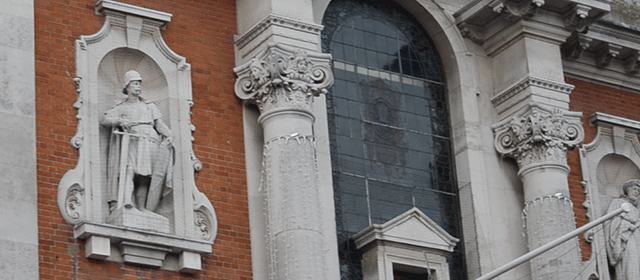
Eudo Dapifer, on Colchester’s town hall. Photo by Steve St. Clair 2014
In the photo above, you can just make out the armorial on Eudo’s shield. Here’s a better view.
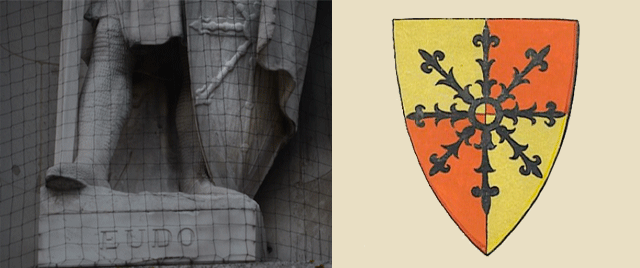
Notice the similarity of Eudo’s shield to the arms of the Mandeville family (right). That is not an accident.
The names St. Clair and Mandeville were often together in medieval England. In December, 2014 I was northeast of London, traveling up to Castle Acre priory and making many stops along the way. One stop was at The Parish Church of St. John the Baptist in Danbury, Essex. This church’s north aisle, the oldest part of the current structure, dates from 1233. From that time until "the restoration of the church in 1866, the north aisle was the private chapel of the Lords of the Manor of St. Cleres and Heyrons and was separated from the body of the church by a screen.” (brochure)
The land of Danbury was owned by a man named Erling pre-conquest. After 1086, the lord was William of Bouville. The tenant-in-chief post-conquest was none other than William de Mandeville. (Domesday Map - Danbury)
More on the Mandevilles
Stephen de Mandeville, lord of the Honour or Erlstoke in Somerset, was associated with Baldwin de Redvers. They went on crusade together (Philips, p. iii). The Redvers family shared the lion rampant arms with the de Morvilles and were their tenants in chief when the de Morvilles first came into England. The Redvers, the de Morvilles, and the St. Clairs of Herdmanston were almost certainly connected by blood. I can prove without any doubt whatsoever that the St. Clairs of Herdmanston were directly related by blood to the Mandeville family thanks to an SNP called P310.
Geoffrey de Mandeville had been excommunicated, so he couldn’t be buried inside the Temple Church. He was left hanging in his coffin from a tree, but finally buried somewhere in in the churchyard or porch of Temple Church in 1163.
There are 9 effigies in Temple Church. One of them is Mandevill, Earl of Essex. Griffith-Jones (appendix II) makes it clear that Burton is not the best source of information on the Temple Church, however David Park (Griffith-Jones pp. 71-74) gives solid evidence that William de Mandeville was the founder of Temple Church in London and was in fact buried there.
The connection that started it all
Whittonstall is a township-chapelry in Bywell-St. Peter parish, Northumberland. It is 3¼ miles N-NW of Shotley-Bridge. On Google Earth, it looks very much like the rest of northern England - rolling hills, cultivated fields, and small roads.
This land first got my attention when I found a Mandeville family living there who bore the engrailed cross.
The Vaux family is also mentioned (Society p. 187, 190, 192), “It seems probably that John de Vaux was a kinsman of the Menevills. By an undated deed in the possession of the Greenwich Hospital Commissioners, John de Vallibus, ‘lord of Bewfront,’ grants his lands at Whittonstall to Adam de Menevyle to hold at the yearly rent of £9 16s.” The Raimes family witnessed some of these legal documents. Remember them? Research at St. Andrew de Bolam showed the Raimes family also bore the engrailed cross on their armorial.
Society (p. 182) has the “manor of Whittonstall and its appurtenances being granted to the Darrayns, in whose possession it appears to have remained nearly a century, and then to have passed to the Menevylls.” That, of course, is the Mandevilles.
That surname, Darrayns, had its origins in Airaines, department of the Somme, about twenty miles to the north-west of Amiens. (Bateson p. 177)
- The church of Airaines was given, c. 1100 by Stephen, count of Aumale (son of Odo, Count of Champagne), to the Cluniac priory of St. Martin des Champs in Paris. The Foundation for Medieval Genealogy has Stephen count of Aumale giving this gift to Saint Martin des Champs with the consent of “Hauisa his wife and her father Ralf de Mortuomari / Mortimer (Stapleton exx). Yeowza !!
Holy cow! The Counts of Champagne married into the de Mortimers
Don’t forget, Hugh de Mortemer was listed by Wace as charging in at Hastings with three families of knights including the Saint Clers.
In his chronicle the Roman de Rou, written between 1160 and 1170, Wace wrote:
- Normant a pie e a cheual
Les assaillment comme uassal
Donc poinst Hue de Mortemer,
Od lui li sire d'Auuiler,
Cil d'Onebac e de Saint Cler;
Engleis firent mult enuerser.
- The Normans attacked them courageously on foot and on horse.
Then Hugh of Mortemer spurred his horse; he had with him the lord of Auvilliers, and the lords of Les Oubeaux and of Saint-Clair. They overthrew many Englishmen. (translation Wace, p. 188)
Who were these Mortemers and Saint Cler?
Loyd (p. 140) has the Mortemers holding land of the Warenne family. Mortemer originated in Mortemer-sur-Eaulne, Seine-Inf., in the arrondissement of Nefuchatel. By 1075, king William I gave Wigmore Castle to Ranulph (Ralph) de Mortimer. Wigmore is located in northwest Herefordshire.
That name Warenne is quite important for the Saint-Clairs. In 1085, Ricardo de Sancto Claro was a witness to charter of the powerful William de Warenne (a “near-kinsman of the Conqueror”) to the priory of Castle Acre. Richardo de Sancto-Claro, or St. Clare, gave the monks of Castle Acre his right in the church in free alms for ever. (Booth, p. 97)
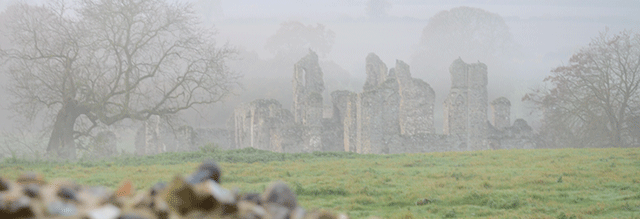
Castle Acre, County Norfolk, England. Photo by Steve St. Clair November 2014
Castle Acre was founded as a Cluniac Priory. It was a daughter house of William de Warenne’s Lewes Priory in East Sussex.

Photo by Matthew Usher in an article about my visit to Castle Acre. See website EDP24.co.uk
That connection between Richard St. Clair and William de Warenne is terribly important. Several sources have William de Warenne and his wife Gundred traveling to Rome and, for unknown reasons, staying in Cluny Abbey. They were quite impressed with these devout monks and decided to found a priory in England for Cluny.
Why Warenne is so interesting

It’s always fun to look at the armorial bearings of families who are circling around one another. The fact that these families all used the chequy arms cannot be ignored. The Warenne / Vaux connection is obvious if you look at my wider research. Both families were involved at Preaux Abbey, Thetford, and Castle Acre. Preaux Abbey is very interesting. That land was held in 1070 by Eudo Rye.
The Dreux family will be interesting for those who believe such a connection to the St. Clair family. I think it is bogus, however I might be wrong - the coats of arms are very similar. Some “researchers” have claimed that he de Dreux are the ancestors of the Sinclairs of Rosslyn. Curiouser and curiouser.
Just so you understand all the inter-relations here, Robert count of Mortain was half-brother of William the Conqueror and the younger brother of bishop Odo of Bayeux. (Morris p. 15)
Bretel St Clare was a witness to the earl of Mortain’s foundation charter of the priory of Montacute, a Cluniac priory. So then, if you follow my research, Bretel was directly related to Robert de Mortain.
That connection with Roger Bigod necessitates a brief mention of his Thetford Priory, just south of Warenne’s Castle Acre Priory. Thetford’s first foundation stone was laid on September 1, 1107 by Roger Bigod. It was, like Castle Acre, a Cluniac priory. (eng)

Roger Bigod’s Cluniac foundation of Thetford Priory, County Norfolk, England. Photo by Steve St. Clair, November 2014
I visited Thetford on my drive north from London. It’s an immense place with enough surviving stonework to get a sense of how beautiful it must have been. The benefactor and witnesses list is an incredible group:
- Bigot
- Savigny
- Warenne
- Bois
- Malet
- Longespee
- Vaux
- Brito
- Albini
- Bosco
- Montchensey
The Bigod name is important to our family DNA study because Hamo St. Clair married Cecilia Bigod, daughter of the very powerful Roger Bigod. Cecilia was the granddaughter of Robert de Tosny. Roger Bigod had several tenants on his lands, one of the most important was the de Vaux family.
Those connections between the Warenne, Mortemer, Mandeville, Bigod, Vaux, and Saint-Clair families are incredible, especially considering my discovery of direct connections all of them had to Stephen count of Aumale. He was the son of Odo, Count of Champagne and Adelaide of Normandy, the sister of William the Conqueror.
St Clears Priory - Parish Church of St Mary Magdalene, in Wales
My friend, Leslie Bolam first brought St. Clears Priory to my attention. The website says the founder is not known. It’s located in St Clears, Carmarthenshire, South Wales and was built in the mid 12th century.
St. Clare, in the county of Carmarthen (GB) was a Cluniac priory traditionally founded by one of the Norman St Clare family around 1100. By the mid-12th century, it became a cell of the Cluniac monastery of St. Martin-des-Champs of Paris.
There is also some dispute about whether or not this small priory is associated with the Saint-Clair family. Here’s your first clue - the website Monastic Wales says lordship of the area at the time of the foundation was the Mortimer family.
Furthermore, St Clears Priory was a dependent of Montacute Priory, Somerset. Montacute was founded between 1078 and 1102 by William, Count of Mortain. It was the only Somerset dependency of Cluny Abbey until 1407. Bretel St Clare was a witness to the foundation charter of the priory of Montacute by William, Earl of Moreton (Mortain), son of Earl Robert.
I have not found hard evidence that the church in Wales was founded by the St Clairs, but the fact that the Mortains were the lords of the land make it extremely likely. Also, the veneration of Mary Magdalene, relatively new at the time, is very interesting.
The Counts of Champagne
Hugh, Count of Champagne founded the order of the Temple. If you read the popular books on the Templars, you will think I just made a mistake. Bernard of Clairvaux and Hugeus de Payen are usually given credit for founding the order and achieving their recognition by the church in 1129 at the Council of Troyes.
But I like to follow the money.
The Counts of Champagne were vastly wealthy in the early 12th century. Hugh, the 1st count of Champagne (1102-1125), owned vast holdings all around Troyes, which later became part of the county of Champaign. He was the youngest son of Thibauld I, count of Blois, Meaux, and Troyes.

Among the lands of the Counts of Champagne was Payns, just 6 miles Northwest of Troyes, where Hugh Count of Champagne met Hugh de Payens. Payens became a member of the Count of Champagne's court.
I drove through Payns on the trip to Troyes. There is practically nothing to see. I went right by it without pulling in. This pic from Google Street view shows how rural the area is.
Several important dates
1100 - The church of Airaines was given by Stephen, count of Aumale (son of Odo, Count of Champagne), to the Cluniac priory of St. Martin des Champs in Paris.
1104 - Hugh de Payen made his first trip to the Holy Land in the entourage of Hugh, 1st Count of Champagne, returning in 1107.
1116 - Bernard of Clairvaux founded his Cistercian house in the valley of Wormwood. The land had been given to Bernard by Hugh, count of Champagne about the time of Hugh's 2nd campaign to Outremer. Both of those now credited with founding the Knights Templars got their money - and I’m betting their instructions - from Hugh, Count of Champagne.
1121 - King Henry I made his first gifts of land to St. Martin des Champs.
1125 - Hugh, Count of Champaign retired and went to the Holy Land for the 3rd and last time as a Knight Templar, one of the very few noblemen to actually join the order.
1127 - Hugh de Payen and several knights returned from the Holy Land to raise money and men to return with them to help fight off the infidel. Payen met with King Henry I of England while Henry was in Normandy.
October 1127 - the Templars received their first grant of land in the west, with a house, a grange, a meadow and a tenement in Provins being given to the Order in October 1127, a gift from Hugh of Champagne’s successor, Theobald, Count of Blois.
January 1129 - the Council of Troyes was held in Troyes.
1130 - Immediately after the Council of Troyes, the winter of 1130, monies and land began flowing into St. Martin des Champs from King Henry I and powerful families in England.
Why?
Those who were benefactors of abbeys and priories were doing so under the condition that the monks there would continue to pray for the souls of their family and their ancestors.
Therefore, one who gave such a gift to St. Martin des Champs, was directly related to the more powerful benefactor. In this case, that would have been the Counts of Champagne.
Last year (2014), I found a blog posting on a Yahoo group, called Crispin Cousins, which validated this approach. They had written several research axioms. The two most important ones are listed here:
1. Benefactors to ecclesiastical institutions are kin of the founder
2. Primary witnesses (i.e., not including those witnessing on behalf of the of institution) of ecclesiastical charters are invariably kin of the primary benefactor; by extension, of course, also kin of the founder.
Now you see the importance of following the money. The benefactors to St. Martin des Champs are kin to the Counts of Champagne -
- Stephen of Aumale, son of Odo count of Champagne
- Robert de Vaux
- Robert Arundel
- William de Brus
- Baldwin de Redvers
- Stephen de Mandeville
Fascinating Discoveries at St. Martin des Champs
The reason I left for France in the first place was evidence of family connections I found in great detail in a chapter of Round’s book regarding St. Martin des Champs.
St. Martin des Champs was founded as a Cluniac priory in 1100 by Stephen count of Aumale, son of Odo, count of Champagne. Odo, Count of Champagne had been Count of Troyes 1047 – 1066. I’ve become very interested in the Cluniacs because their spirituality would give rise to the monastic ideal of Citeaux and Bernard of Clairvaux. And if they Counts of Champagne were interested, it likely had a Templar connection.
EYC (p. 27) says the Stephen, count of Aumale, and in England earl of Albemarle, married Hawise, daughter of Ralph de Mortemer. Stephen was the son of Odo, count of Champagne by his wife, Adelaide of Normandy, sister of William the Conqueror. Odo was the 3rd husband of Adelaide. She had also been married to (1) Ingelram, count of Ponthieu "sire d'Aumale" and (2) Lambert, count of Lens. That Count of Lens connection is fascinating, but this post is getting too long to go into it.
What do we know about the benefactors to St. Martin des Champs?
The Vaux family - This one is directly paternally related to the members of the L193 St. Clair lineage (myself included) to the Vaux's Barnbarroch line. Our DNA SNP match proves we share an ancestor nearly (or close to) the 1200s. This wasvalidated in January 2015 with a FTDNA Big Y test. Also, our L152* SNP lineage has a Big Y SNP match with the Fox surname (likely a Vaux derivative). He has ties to Somerset England, which make this very interesting given the Saint-Clair landholdings and benefaction there.
Arundel - a town in West Sussex. The title Earl of Arundel began in 1138 with William d'Aubigny. There were 2 d'Aubigny families. The ones we are interested in were the d'AUBIGNY FAMILY OF ARUNDEL (also the "Pincerna" d'Albignys): the descendants of Roger de Tosny who became Lord of Belvoir (pronounced "Beever"). Yes, it looks like it would be pronounced Belvoir, but the English call it Beever.
William d'Aubigny, 1st Earl of Arundel, an English nobleman, was the son of William d'Aubigny "Pincerna" and Maud Bigod, daughter of Roger Bigod, 1st Earl of Norfolk.
Roger Bigod’s major tenant in England was the de Vaux. Given that the Vaux family were also benefactors of St. Martin des Champs, seeing a Bigod family connection here is not a surprise. Some of the Vaux family were tenants of the Bigod family in England.
The 1st Earl of Arundel was in the household of King Henry I of England.
The Brus family - Robert the Bruce was directly descended from this family.
The Redvers family - Went to England in the Norman Invasion and became very powerful. They were directly related to, and gave land to, the de Moreville family, who gave land to the St. Clairs of Herdmanston in 1162, the first recorded land the Saint-Clair family held in Scotland. This means the Herdmanstons were the original Saint-Clairs / Sinclairs in Scotland.
The Mandeville family - Geoffrey de Mandeville founded Temple Church in London for the Knights Templar. He took the oath of the Templars on his deathbed and is buried on the grounds of Temple Church. There is an effigy of him inside. Mandeville was closely associated with Eudo Dapifer via a marriage to Eudo’s daughter Margaret. His lands at Eaton Socon and Walkern turned into the barony of the ancestors of the Saint-Clairs of Herdmanston.
More on St. Martin des Champs
There had been other religious houses, and religions, at St. Martin des Champs. For instance, the priory was built over a Merovingian burial site.

Floorplan of St. Martin des Champs and a Merovingian sarcophagus inside. Photo Steve St. Clair 2014.
Just 850 feet East of St. Martin des Champs is an interesting building. Or, rather, was an interesting building during the medieval era: La Tour Du Temple - the headquarters of the Knights Templar in Europe.

All that remains of the European headquarters of the Knights Templar in Europe, a street name. Rue de Temple, about 850 feet East of St. Martin des Champs.
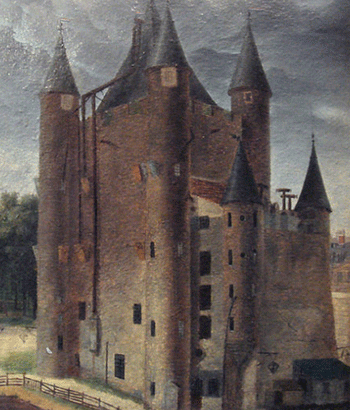
Wikipedia Commons, public domain - http://fr.wikipedia.org/wiki/Tour_du_Temple
Don’t underestimate the importance of proximity. Here’s an example:
Back in November 2014, I was over in England, driving from London up to Castle Acre, Norfolk. Along the way, I stopped off at Danbury to see The Parish Church of St John the Baptist. This is a very important site for our family in England. Inside are 3 wooden effigies of crusader knights, at least 1 of which is believed to be a St. Clair.
As I drove west on the A414 (wrong side of the road, driving a stick shift), I was wondering which of our lineages these medieval Saint-Clairs might be. Then, on my right, I saw a sign for a little town named Woodham Mortimer. This could not be mere chance. You’ve read the importance of the name Mortemer to our family. Now, less than a mile east of Danbury I find a town with the name.
Later, as I looked it up in my various research resources, I discovered that at the time of the Domesday inquest in 1086, Woodham Mortimer was owned by Ranulf Peverel. It had 14 households, 4 cows, 46 pigs, 135 sheep, 45 goats, and 4 calves (Domesday). Later, the parish, formerly called Little Woodham, was given by King Henry II to Ralph de Mortimer, the second son of Roger de Mortimer and Isabel de Ferrers of Wigmore Castle in Herefordshire. Their eldest son, Roger Mortimer, 1st Baron Mortimer, married Maud de Braose (Bruce), no doubt the same family as the benefactors to St. Martin des Champs.
The St. Clere family held their lands at Danbury until the time of Edward I. After that, it passed to the Veres, earls of Oxford. Coincidence? I doubt it. (Cromwell p. 51)
To sum it all up:
- The European headquarters for the Order of the Temple was 850 feet east of St. Martin des Champs.
- St. Martin des Champs was heavily funded by Stephen, Count of Champagne.
- The Counts of Champagne were “the money” behind the Templar order.
- The Mortemers married into the Counts of Champagne. They also brought the Saint Clairs into England during the Norman Conquest.
- Many of the surnames of the benefactors to St. Martin des Champs were part of the Saint-Clair SuperFamily, inter-related by DNA SNPs and showing up repeatedly in medieval documents.
- Baldwin de Redvers and Stephen de Mandeville, who gave land and money to St. Martin des Champs, then took up the cross.
- The Redvers, Moreville, and Saint-Clairs are likely related.
- The Mandevilles connect to the St. Clairs of Herdmanston by YDNA SNPs.
- Geoffrey de Mandeville founded Temple Church in London. He was made a Knight Templar on this deathbed and buried at Temple Church, despite formerly being excommunicated.
In short, there are tremendously strong connections between this wider Saint-Clair SuperFamily and powerful families associated with the Knights Templar.
Sources
Bateson, “A History of Northumberland, Volume 6” The Northumberland County History Committee, Newcastle-Upon-Tyne, edited by Edward Bateson, Allen Banks Hinds, John Crawford Hodgson, Herbert Henry Edmund Craster, Kenneth Hotham Vickers, Madeleine Hope Dodds, Printed by Andrew Reid & Company London 1902
Booth, M. "The History and Antiquities of the County of Norfolk: Launditch, Mitford, and Shropham. Volume VIII. Containing the Hundreds of Launditch, Mitford, and Shropham." Printed by J. Crouse, for M. Booth, 1781
Britnell, Richard & John Hatcher, “Progress and Problems in Medieval England,” Cambridge University Press, 1996 ISBN 0 521 55036
Brochure - A small, 4-page flyer I picked up inside The Parish Church of St. John the Baptist in Danbury, Essex.
Brown, Vivien, “Eye Priory cartulary and charters, Part 2,” First published 1992 for the Suffolk Records Society by The Boydell Press an imprint of Boydell & Brewer Ltd, Suffolk, ISBN 0 85115 322 4
Camden, William, Esquire “Remaines Concerning Britaine: Their Languages. Names... [etc.]” Printed by Thomas Harper, for John Waterson, 1636
Carmarthenshire, Antiquarian Society and Field Club “Transactions, Volumes 1-6,” Carmarthenshire (Wales) 1906
Church Monuments Society - http://www.churchmonumentssociety.org/London_1.html
Cromwell, Thomas Kitson, “Excursions in the county of Essex, Vol. 1” printed by T. Davison, Whitefriars 1818
Cownie, Emma, “Religious Patronage in Anglo-Norman England, 1066-1135” The Royal Historical Society, The Boydell Press, 1998 ISBN 978-0-86193-232-0
Domesday Map - Danbury - http://domesdaymap.co.uk/place/TL7705/danbury Professor John Palmer and George Slater
Domesday Map Woodham Mortimer - http://domesdaymap.co.uk/place/TL8104/woodham-mortimer Professor John Palmer and George Slater
ENG, English Heritage Website -
http://www.english-heritage.org.uk/daysout/properties/thetford-priory/history-and-research
EYC, "Early Yorkshire Charters, Volume 3" edited by William Farrer, Cambridge University Press 2013 ISBN 978-1-108-05825-4
Farmer, David Hugh, “Benedict's Disciples,” Gracewing Publishing, 1995 ISBN 0 85244 274 2
Finn, R. Welldon, M.A., “An Introduction to Domesday Book” Barnes and Noble 1963 ISBN: 9780313250484
GB Historical GIS / University of Portsmouth, History of St Clears in Carmarthenshire | Map and description, A Vision of Britain through Time.
URL: http://www.visionofbritain.org.uk/place/8773
Date accessed: 03rd January 2015
Golding, Brian, “The Coming of the Cluniacs, “Anglo-Norman Studies III. Proceedings of the Battle Conference 1980, edited by R. Allen Brown, The Boydell Press, ISBN 978-0-85155-141-0
Green, Judith A. “The Government of England Under Henry I,” Published by the Press Syndicate of the University of Cambridge, 1986 ISBN 0 521 37586 X
Griffith-Jones, Robin & David Park, "The Temple Church in London: History, Architecture, Art" Boydell & Brewer, 2010 ISBN 978 1 84383 498 4
KR-1 - Keats-Rohan, K. S. B. V-2, “Domesday Descendants: A Prosopography of Persons Occurring in English Documents 1066-1166 II: Pipe Rolls to `Cartae Baronum' “ (Vol 2) (Hardcover), by K.S.B. Keats-Rohan, Boydell Press (April 15, 2002) ISBN-10: 0851158633, ISBN-13: 978-0851158631
KR-2 - Keats-Rohan, K.S.B., "Belvoir: The Heirs of Robert and Berengar de Tosny," in Prosopon: Newsletter of the Unit for Prosopographical Research 9 (Jul 1998). available at this link:
http://users.ox.ac.uk/~prosop/prosopon/issue9-1.pdf
Kibler, William W., “Medieval France: An Encyclopedia” Psycholog Press, 1995 ISBN 0—8240-4444-4
Mapping Gothic France website page on Saint-Martin-des-Champs http://mappinggothic.org/building/1166 © Media Center for Art History, Columbia University & Art Department, Vassar College
Monastic Wales website re: St. Clears Priory - http://monwales.tth7.co.uk/site/12
Morris, Ian, “Domesday Book: Devon” Phillimore & Co Ltd; First Edition edition, 1985 ISBN 0850334926
Loyd, Lewis C. “The Origins of Some Anglo-Norman Families,” Genealogical Publishing Company, 1951 ISBN 0806306491
Neveux, François, Claire Ruelle, “A brief history of the Normans: the conquests that changed the face of Europe,” Robinson Publishing, May 29, 2008 ISBN: 1845295234
Pearce, Christopher, "The Cluniacs in Wales: Malpas and St Clears" an article for "Monastic Wales," a website - http://www.monasticwales.org/showarticle.php?func=showarticle&articleID=8
Planché, James Robinson, “The Conqueror and His Companions, Volume 2” London: Tinsley Brothers 1874
Poulson, George, “The history and antiquities of the seigniory of Holderness” Thomas Topping, Bowlalley-Lane; and W. Pickering, London 1841
Round, John Horace (editor), “Calendar of documents preserved in France: illustrative of the history of Great Britain and Ireland. A.D. 918-1206. Vol. 1” H.M. Stationery Office, 1899
Sinclair, Peter, “Medieval Walkern and Magna Carta” Walkern History Society, Digital edition by Frontline States Ltd 2013 ISBN 978-1-873639-0601
Note: Peter also maintains a terrific website at http://SinclairGenealogy.info
Society of Antiquaries of Newcastle-upon-Tyne, “Archaeologia Aeliana: Or, Miscellaneous Tracts Relating to Antiquities, Volumes XI,” Printed by Andrew Reid 1886
Stapleton, Thomas, “Magni rotuli Scaccarii Normanniae sub regibus Angliae: contains "the later Roll of Richard I.” Society of Antiquaries of London, 1844
Tour du Templar - Wikipedia Commons, public domain - http://fr.wikipedia.org/wiki/Tour_du_Temple
Vincent, Nicholas, "Warin and Henry Fitz Gerald, The King's Chamberlains" The Origins of the Fitzgeralds Revisited. Presented to "Anglo-Norman Studies 21: Proceedings of the Battle Conference 1998," edited by Christopher Harper-Bill, Boydell & Brewer, 1999
Wace, Glyn S Burgess; Elisabeth M C Van Houts, "The History of the Norman People : Wace's Roman de Rou" Boydell Press, 2004 ISBN 1 84383 007 8
Wareham, Andrew, “Lords and Communities in Early Medieval East Anglia,” Boydell Press, Jan 1, 2005 ISBN 1 84383 155 4
Webster, Hutton, “Medieval and Modern History,” D.C. Heath & Company, 1919
Wikipedia - A useful, but not yet fact-checked list Cluniac houses in Britain. It is, after all, Wikpedia - http://en.wikipedia.org/wiki/Cluniac_priories_in_Britain
